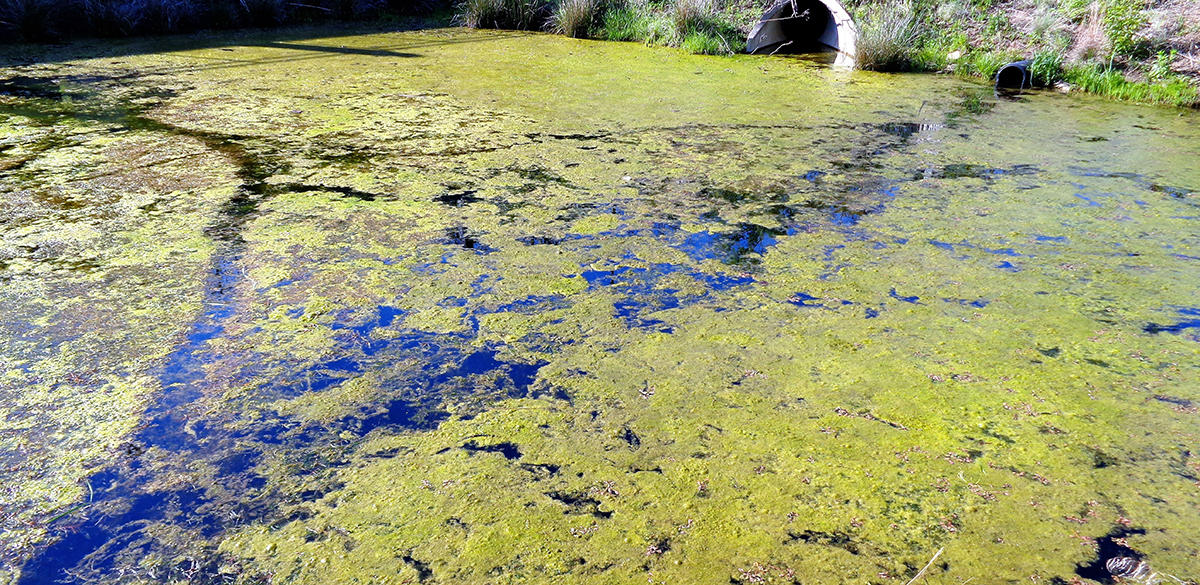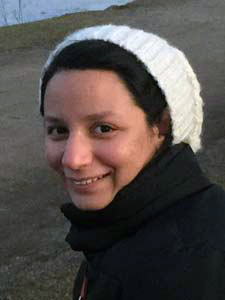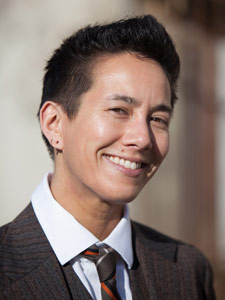Lake Erie’s toughest challenges tackled by doctoral students
Student researchers at The University of Akron (UA) are, to borrow Hamlet’s phrase, taking arms against a sea of troubles – or, in this case, a lake full of invasive mussels, algal blooms and other contaminants.

Elena Stachew
Elena Stachew, Kelly Siman, Banafsheh Khakipoor and Lamalani Siverts are doctoral students in UA’s Integrated Bioscience Program. They are researching and developing technologies and programs — including bio-inspired coastal infrastructure, a low-cost spectrometer that monitors nutrient pollution, and K-12 curricula — to restore and maintain the health of Lake Erie and the populations it serves.
New challenges
The lake, recovering from severe pollution in the 1960s (punctuated by the infamous conflagration of one of its tributaries, the Cuyahoga River), suffered fresh woes in the 1980s with the introduction of non-native zebra and quagga mussels, thought to have been transported on ships passing through the St. Lawrence Seaway. In addition to clogging water intake structures and accumulating on docks, buoys, boat hulls and anchors, the invaders have wreaked havoc on the ecosystem, leading to the near-total extinction of its native clam population, according to the Environmental Protection Agency.

Kelly Siman
“Zebra and quagga mussels disrupt the early stages of the food chain in the Great Lakes, taking food and habitat away from other small organisms – which in turn affects the health and diversity of our fish populations,” says Stachew, who, with her colleagues, is a member of the Biomimicry Fellowship Program through UA’s Biomimicry Research and Innovation Center (BRIC), an interdisciplinary center dedicated to innovation inspired by nature.
The fellowship program – which Dr. Emily Kennedy, BRIC director of external relations and former fellow, says is the first of its kind worldwide – allows Stachew and her peers to conduct dissertation-related research through assistantships with regional corporate partners, such as Avon Lake Regional Water (ALRW), the Teaching Institute for Excellence in STEM (TIES), the Cleveland Water Alliance (CWA) and Biohabitats. (The latter two are in partnership with the Ohio Department of Natural Resources Office of Coastal Management).

This vast algae bloom is the result of fertilizer run-off.
Stachew adds that the mussels are not alone in disrupting the ecosystem. Sediment suspension – uplifted and eroded soil and debris, coming from agricultural and urban runoff, storm surges and other physical disturbances – has been clouding nearshore waters, preventing fish from finding food and plants from photosynthesizing.
Natural infrastructure
“To improve water quality, we need to reduce incoming sediment flows and re-suspension,” says Stachew. She is working in the lab to develop small-scale, bio-inspired coastal infrastructure (such as breakwaters and seawalls) which, like coral reefs, mangrove forests and other natural structures, reduce incoming wave energy and create pockets of calmer water for aquatic flora and fauna to flourish.
Meanwhile, Stachew’s peers are contending with another problem that has plagued Lake Erie for the past decade — the proliferation of blue-green algae, or cyanobacteria, in the form of annual, widespread outbreaks of unsightly, and sometimes toxic, green foam and slime known as algal blooms.

Banafsheh Khakipoor
“They’ve [algal blooms] been happening naturally for ages, but what we’re truly concerned about is that they’re becoming more and more frequent, and bigger and more toxic,” says Siman. She then explains that nutrient pollution – or an excess of phosphorus and nitrogen, entering the lake through agricultural and urban runoff, often in fertilizer and waste – is a major contributor to the growth of cyanobacteria, which thrive especially well in Erie’s warm water each summer. (Zebra and quagga mussels compound the problem by excreting phosphorus.)
The multiplying cyanobacteria form thick, floating mats of green scum on the water’s surface, blocking sunlight to organisms below. When the cyanobacteria decompose, they not only deplete the water of oxygen, creating “dead zones” inhospitable to life, but they sometimes release microcystin, a toxin harmful to animals and humans. In 2014, harmful algal blooms (HABs) contaminated the water supply in Toledo, leading to a three-day ban on water usage – including drinking, cooking, bathing and tooth brushing – for the city’s more than 400,000 residents.

Lamalani Siverts
To better predict, detect and prevent the formation of HABs, Siman has been working with Khakipoor and UA’s Dr. Hunter King, assistant professor of polymer science; Jiansheng Feng, a research scientist in polymer science; and Dr. Adam Smith, assistant professor of chemistry, to develop what Siman says is a much-needed, widespread system for monitoring nutrient pollution. Her team’s startup company, Erie Open Systems LLC, has won more than $35,000 in funding and support (including a Microsoft AI for Earth grant and a $10,000 first-place prize through UA’s “Be the Change 10K” pitch competition) for its low-cost, easy-to-use, handheld spectrometer device that detects the presence of phosphates and nitrates in water samples.
Citizen scientists can help
“What we need is a long-term monitoring program, and not just long-term at one geographic location,” Siman says. “It just is not feasible to go out with an expensive spectrometer and take measurements every day and after rain events at multiple points in time and at multiple geographic locations. So we decided to see if we could develop a citizen science-based monitoring system that was low-cost and easy to use, but accurate enough to understand long-term trends so that we could crowdsource the data.”
One uses the spectrometer by pouring a sample of lake water, mixed with chemical reagents, into one of its 3D-printed compartments, and a control sample of tap water into another compartment. Then, the operator beams each sample with diffracted light (that is, light split into spectra of colors), and the presence of phosphates and nitrates can be detected, via computer analysis of images taken by a smartphone, by comparing the spectra in each sample.

First-grade students at Old Trail School in Akron use the spectrometer developed by Kelly Siman and her team for use in K-12 classrooms. Photo: Kelly Siman
Siman points out that while commercial spectrometers range from $1,200 to $3,400 and require a trained operator, her team’s spectrometer costs about $40 in parts and can be packaged in kits for use in K-12 classrooms. In fact, the spectrometer has been operated by students as young as the first grade, who used smartphones to photograph the differentiated spectra and upload the images to a central database for analysis. Erie Open Systems is working with Dave Shellhaas, director of curriculum at Midwest Regional Educational Service Center in Bellefontaine, Ohio, to create a curriculum for use in schools.
Siverts, also, through sponsoring organizations TIES and ALRW, has been integrating water treatment concepts into K-12 classrooms, giving lectures on water quality and taking students to water treatment and wastewater plants. Such educational efforts are characteristic of “citizen science,” a movement in which the public is encouraged to contribute to scientific research.
Protecting water resources
“Right now, science is very much directed to scientists or researchers, but that does not necessarily need to be true,” says Khakipoor who, through TIES, teaches a computer programming course (called “Bee a Coder”) which has elementary students communicate through coding activities that imitate the communicative “dance” of bees. “Because all of us, at the end of the day, are scientists – we all do experiments in our own lives.”
Khakipoor and Siverts, through ALRW, are developing a computer system that uses artificial neural networks, loosely inspired by the thinking and learning process of the human brain, to better analyze data and predict the occurrence of HABS and dead zones in Lake Erie.
“I became interested in drinking water quality after living in California, where water is scarce and management is a social responsibility shared by all citizens,” Siverts say. “I see drinking water resources as our next big global issue.”
Media contact: Lisa Craig, 330-972-7429 or lmc91@uakron.edu.
